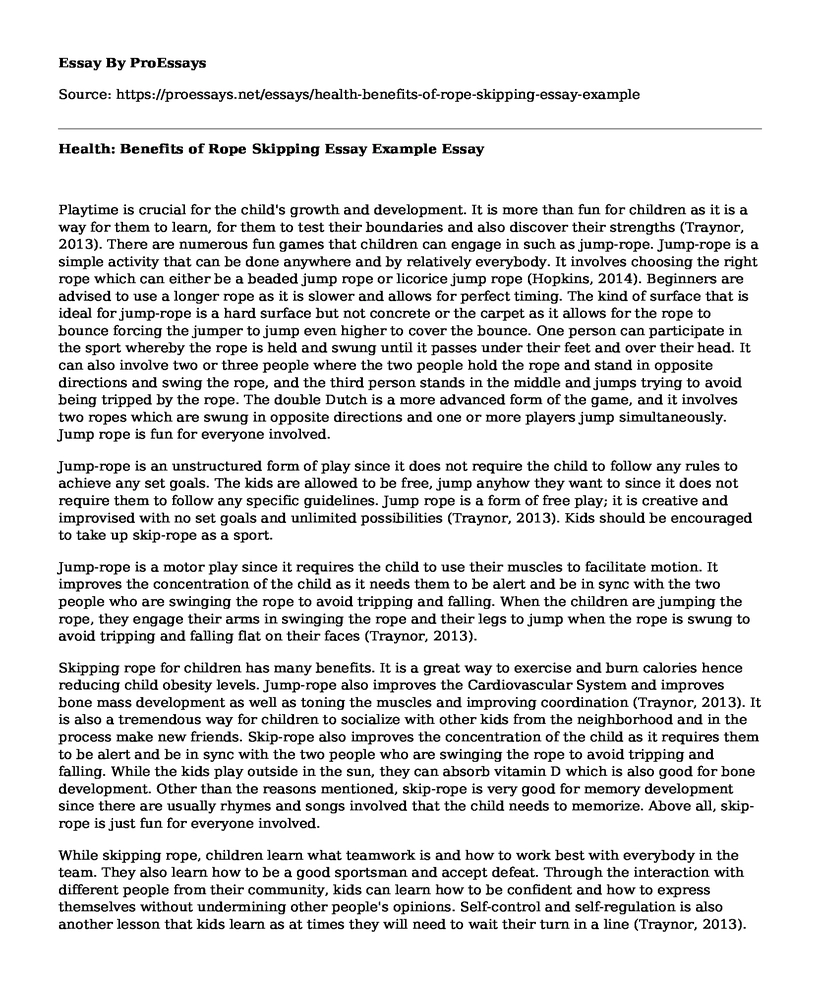Playtime is crucial for the child's growth and development. It is more than fun for children as it is a way for them to learn, for them to test their boundaries and also discover their strengths (Traynor, 2013). There are numerous fun games that children can engage in such as jump-rope. Jump-rope is a simple activity that can be done anywhere and by relatively everybody. It involves choosing the right rope which can either be a beaded jump rope or licorice jump rope (Hopkins, 2014). Beginners are advised to use a longer rope as it is slower and allows for perfect timing. The kind of surface that is ideal for jump-rope is a hard surface but not concrete or the carpet as it allows for the rope to bounce forcing the jumper to jump even higher to cover the bounce. One person can participate in the sport whereby the rope is held and swung until it passes under their feet and over their head. It can also involve two or three people where the two people hold the rope and stand in opposite directions and swing the rope, and the third person stands in the middle and jumps trying to avoid being tripped by the rope. The double Dutch is a more advanced form of the game, and it involves two ropes which are swung in opposite directions and one or more players jump simultaneously. Jump rope is fun for everyone involved.
Jump-rope is an unstructured form of play since it does not require the child to follow any rules to achieve any set goals. The kids are allowed to be free, jump anyhow they want to since it does not require them to follow any specific guidelines. Jump rope is a form of free play; it is creative and improvised with no set goals and unlimited possibilities (Traynor, 2013). Kids should be encouraged to take up skip-rope as a sport.
Jump-rope is a motor play since it requires the child to use their muscles to facilitate motion. It improves the concentration of the child as it needs them to be alert and be in sync with the two people who are swinging the rope to avoid tripping and falling. When the children are jumping the rope, they engage their arms in swinging the rope and their legs to jump when the rope is swung to avoid tripping and falling flat on their faces (Traynor, 2013).
Skipping rope for children has many benefits. It is a great way to exercise and burn calories hence reducing child obesity levels. Jump-rope also improves the Cardiovascular System and improves bone mass development as well as toning the muscles and improving coordination (Traynor, 2013). It is also a tremendous way for children to socialize with other kids from the neighborhood and in the process make new friends. Skip-rope also improves the concentration of the child as it requires them to be alert and be in sync with the two people who are swinging the rope to avoid tripping and falling. While the kids play outside in the sun, they can absorb vitamin D which is also good for bone development. Other than the reasons mentioned, skip-rope is very good for memory development since there are usually rhymes and songs involved that the child needs to memorize. Above all, skip-rope is just fun for everyone involved.
While skipping rope, children learn what teamwork is and how to work best with everybody in the team. They also learn how to be a good sportsman and accept defeat. Through the interaction with different people from their community, kids can learn how to be confident and how to express themselves without undermining other people's opinions. Self-control and self-regulation is also another lesson that kids learn as at times they will need to wait their turn in a line (Traynor, 2013).
Kids should be encouraged to take up jumping rope as a sport as it is crucial for their growth and development. Jump rope is easy to learn as it only requires a rope or two in the case of double Dutch, a steady ground and one or more players for the fun to begin. It has numerous health benefits, and the kids also learn valuable lessons that they will apply in their future.
References
Traynor, M. (2013). Health: Benefits of Rope Skipping For Kids. www.melissatraynor.com/benefits-of-rope-skipping-for-kids/
Hopkins, M. (2014). Buy Jump Ropes: Learning to Jump-Rope? 12 Steps to Skipping Stardom. https://www.buyjumpropes.net/resources/how-to-jump-rope/
Cite this page
Health: Benefits of Rope Skipping Essay Example. (2022, May 26). Retrieved from https://proessays.net/essays/health-benefits-of-rope-skipping-essay-example
If you are the original author of this essay and no longer wish to have it published on the ProEssays website, please click below to request its removal:
- Research Paper Sample on Healthcare Quality Outcomes
- Immunology of Oral Candidiasis Paper Example
- Diagnosis, Treatment and Complication of Deep Carious Lesions and Pulp Exposure
- Electronic Cigarettes Essay Example
- What Are the Health Benefits Associated With the Consumption of Caffeine?
- Radiographers & Operators: Applying 3 Principles to Ensure Safety - Essay Sample
- BPH: Anatomic Prostate Enlargement & Its Complications - Free Essay Example







